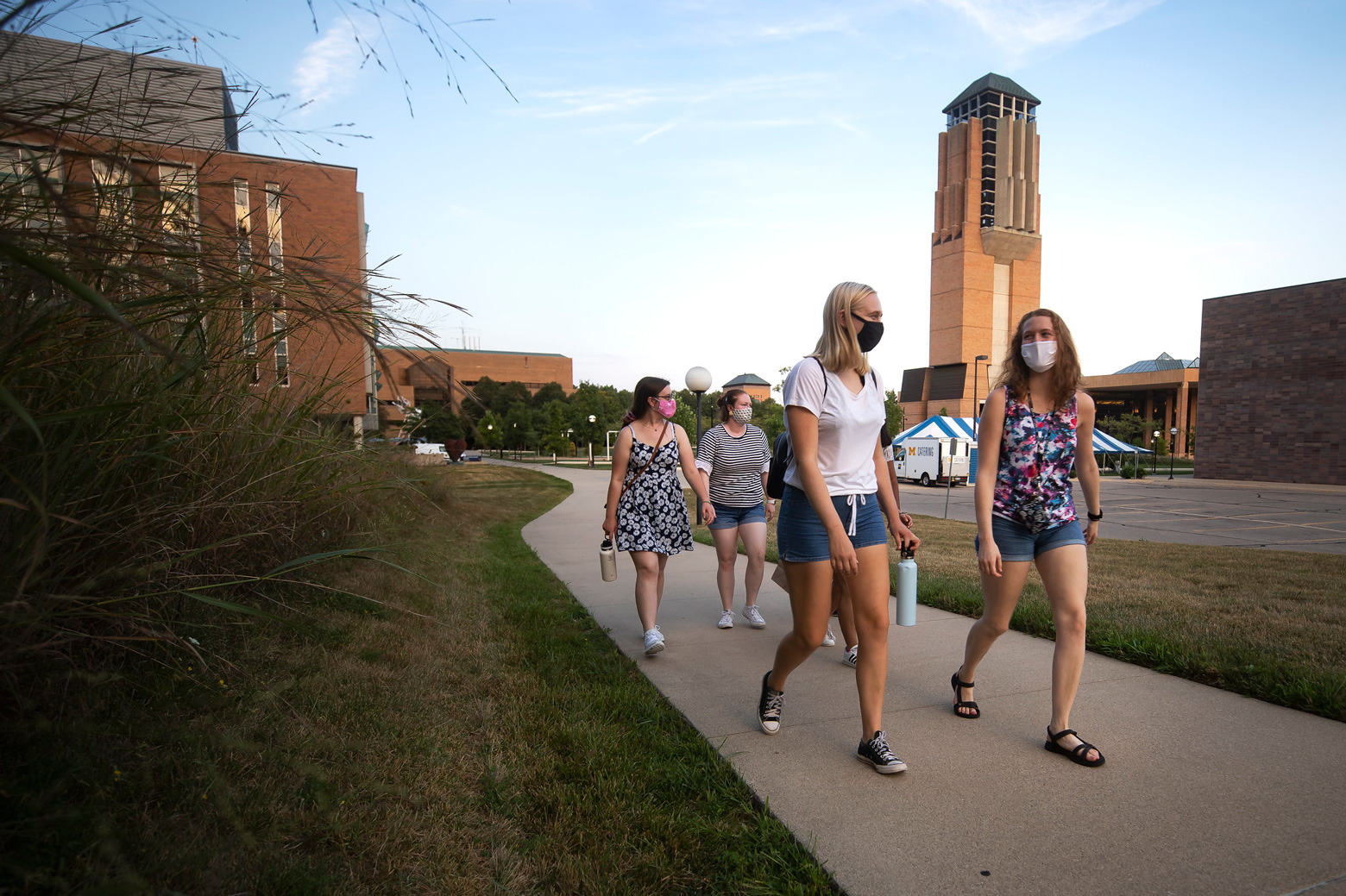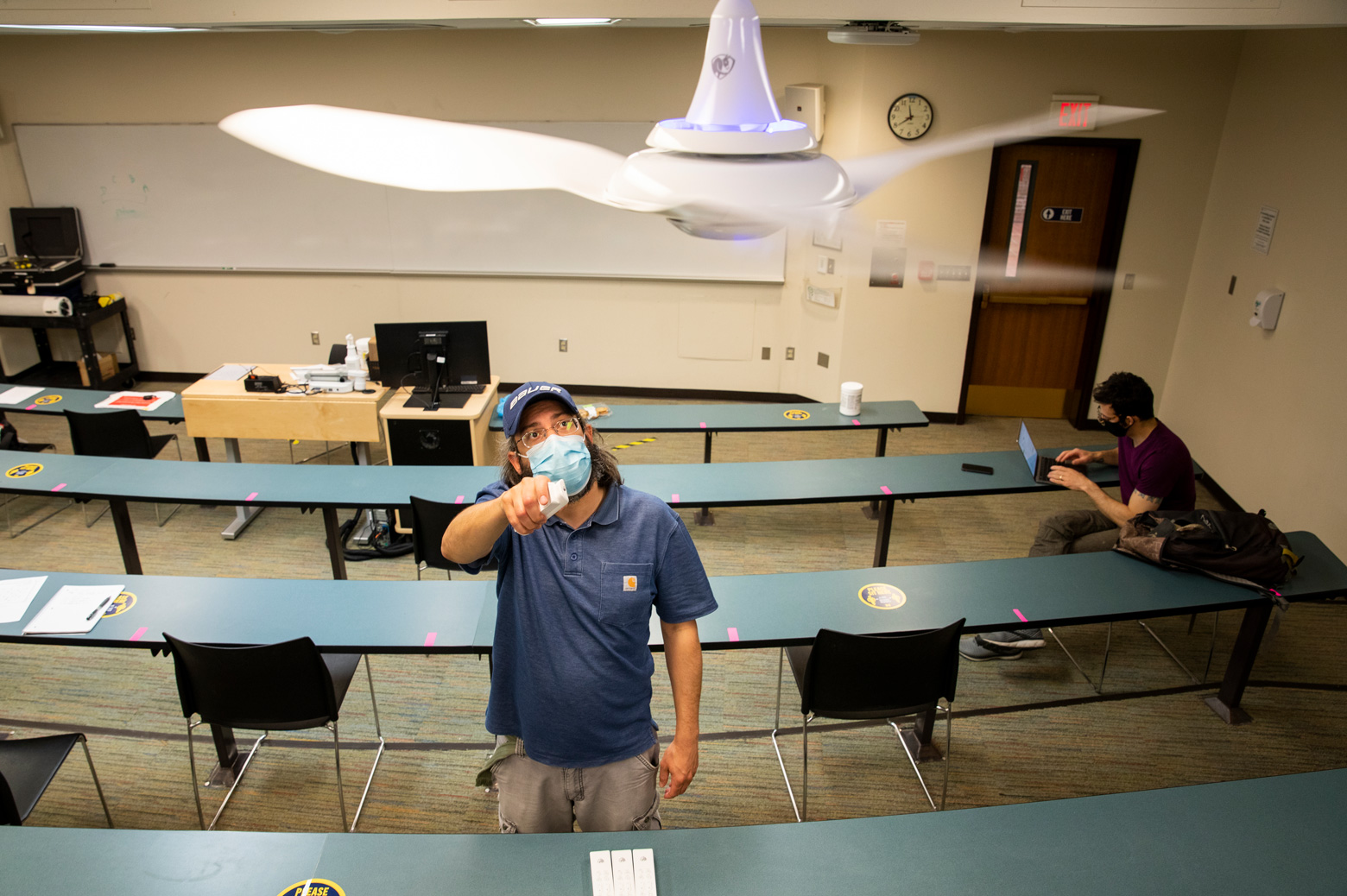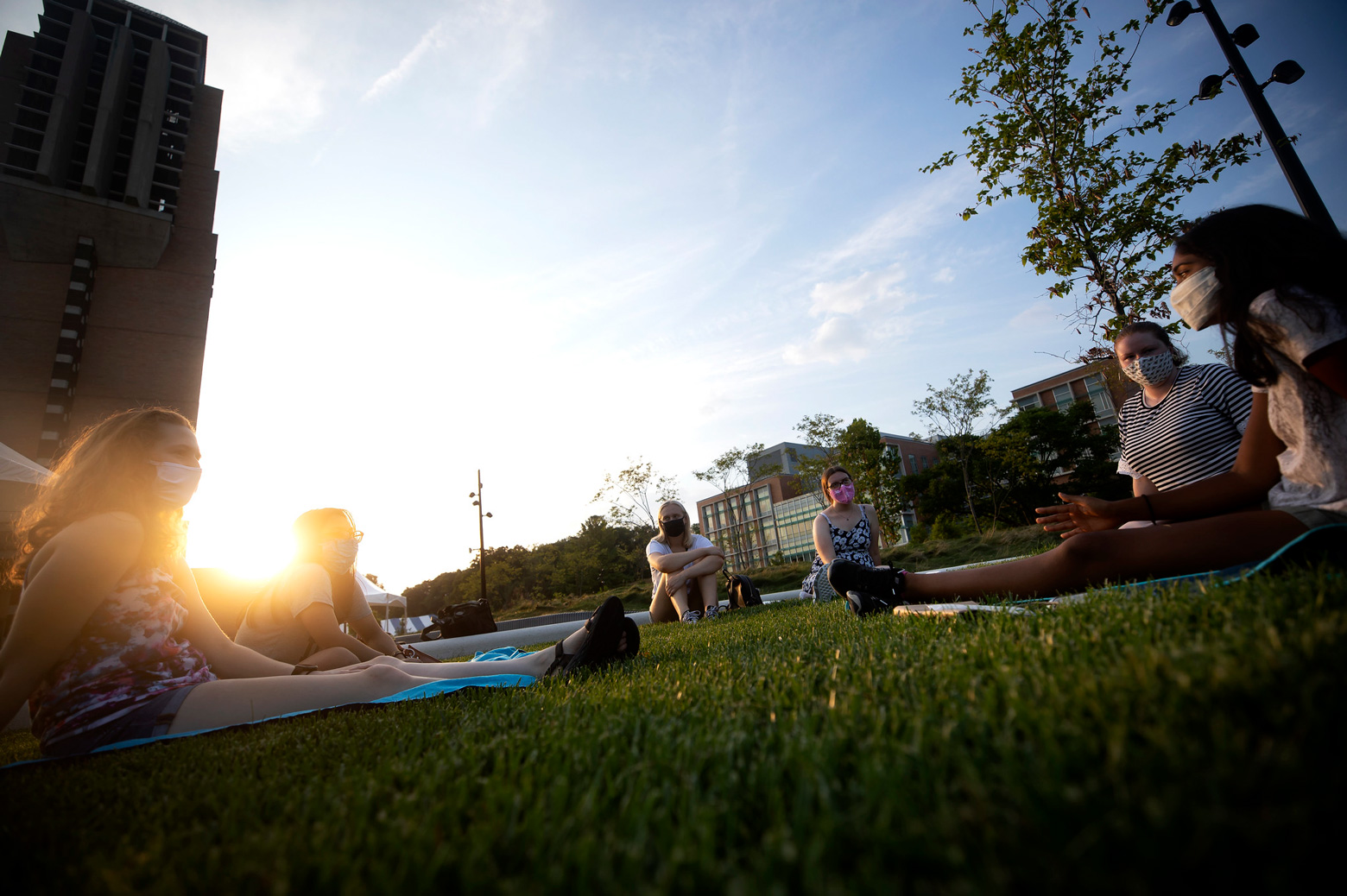A resilient campus
How engineers are applying their expertise for future planning.
Five teams at Michigan Engineering are investigating ongoing COVID-19-related issues on campus. Their work could inform College and University decision making for creating a more resilient campus. These represent the latest efforts by the College’s pandemic-inspired “SkunkWorks” program, which began in 2020.

 Enlarge
Enlarge
Risk-informed decision making for classrooms
How would vaccination rates, masks, enhanced air filtering, ultraviolet light inactivation and various room occupancy limits affect COVID risks in classrooms going forward? Those are the core questions for a team led by Seth Guikema, professor of industrial and operations engineering and civil and environmental engineering and Jim Bagian, clinical professor of industrial operations and engineering, aerospace engineering, and research professor of anesthesiology. The two are co-founders of the Center for Risk Analysis Informed Decision Engineering.
The group is modeling the probability of becoming infected from COVID exposure inside classrooms and the probability of experiencing different health outcomes from these infections. Their model considers class sizes and classroom characteristics in order to simulate all class meetings in any given semester. The researchers are also providing estimates of the likelihood of other, more familiar events in an effort to provide context.
The project is unique in that it explores potential outcomes across a whole semester. Similar endeavors at other institutions only model a single class period or instance of being indoors.
“There is no one silver bullet that will reduce the risks from COVID-19 to zero,” Bagian said. “Vaccines, when effective, are currently a strong countermeasure. However, pursuing a more comprehensive approach that is based on a collection of mitigation activities can create what we call ‘defense in depth’ that offers a more robust and resilient reduction in risk of infection or harm from COVID-19.”
U-M is requiring students living on campus in the fall to be vaccinated. There’s currently no such requirement for those living off campus, nor for faculty members or staff.
The team aims to provide a risk-informed menu of hazards, their associated risks, and potential mitigation options along with their costs.
“Managing risk involves balancing competing goals, such as health, education, mental wellness, university solvency, continuity of important research projects, and the well-being of our local community, to name a few,” Guikema said.
Modeling airflow and potential virus transmission in classrooms

 Enlarge
Enlarge
If someone with COVID-19 were to attend class, how many infectious aerosol particles could others around the room expect to inhale under various mitigation scenarios? The question is as complicated as it is critical to limiting the indoor spread of this and other airborne viruses.
Jesse Capecelatro, assistant professor of mechanical engineering, leads a team that’s working to improve the models used to understand this process. The answers he arrives at will feed directly into the risk-informed decision making team’s analyses.
Aerosols are small virus-laden particles emitted when infected people breathe and talk. They’re also present in coughs and sneezes, alongside the “large respiratory droplets” that typically fall to the ground within a short distance of their source. Infectious aerosols make COVID-19 “airborne,” a classification the Centers for Disease Control only recently confirmed despite many months of supporting evidence from the research community.
Masks do protect against aerosols, but at varying levels depending on the kind of mask and how well it fits.
There’s a lot we don’t know about how these particles behave indoors, but a core conundrum is that while aerosols do not stay within six feet of their source, they’re also not uniformly distributed throughout a room.
“The idea that sitting six feet apart completely protects you is somewhat misleading when it comes to aerosols,” Capecelatro said. “If masks are worn indoors, direct transmission from one person to another is of less concern, and it’s these airborne particles that linger and move with the background flow that we need to worry about. The benefit of social distancing is twofold: it ensures there are fewer people in the room, which reduces the chances of someone sick being present. And if someone is sick, then fewer people are exposed.
“But if you’re in a room for 90 minutes, you’re almost guaranteed to breathe in some portion of what everyone is breathing out.”
At the same time, Capecelatro points out, different parts of a room will have different risk levels, depending on many factors, including: how HVAC vents affect aerosol trajectories, how effective windows or HVAC are at bringing in fresh air, and how many virus particles an infected person emits. Typical indoor airborne transport models do not take this uncertainty or variability into account.
Also involved in this project are Margaret Wooldridge, an Arthur F. Thurnau Professor in the Department of Mechanical Engineering; Kevin Maki, the Richard B. Couch Development Professor of Marine Hydrodynamics in the Department of Naval Architecture and Marine Engineering; Andre Boehman, professor in the Department of Mechanical Engineering; and Krzysztof Fidkowski, associate professor in the Department of Aerospace Engineering.

 Enlarge
Enlarge
“Almost all existing indoor airborne transmission models being used for risk assessment are built upon the assumption that the virus is instantaneously spread out uniformly throughout the room at all times,” Capecelatro said. “In reality, indoor spaces are rarely well mixed. That has important consequences when predicting transmission, or dose, and subsequently risk. Our major effort here is to address that.”
To do this, the team will perform high-fidelity computational fluid dynamics simulations and sensitivity studies. They’ll also run experiments in classrooms using a smoke machine and particle spectrometers—similar to work they’ve done for the U-M Dental School and Blue Bus. Their experiments will explore the impacts of different mitigation measures including occupancy limits, masks and increased ventilation.
Resilient classroom scheduling
Even as COVID-19 case rates decline, uncertainties will continue to pose challenges for space planning.
“The uncertainties include both the supply side and demand side,” said Siqian Shen, associate professor of industrial and operations engineering. “For example, we may have students unable to join in person or arrive at campus on time due to international travel and visa issues. If there are outbreaks in certain buildings, we may need to make adjustments. Or some students or instructors may need to quarantine and be unable to join classes in person for a long period.”
Shen leads a team that is using mathematical modeling and simulation to develop tools to produce resilient class schedules that can be more easily modified if necessary.
These tools could help optimize schedules based on variables like room capacity, how much a given class benefits from in-person instruction, and disease risk. It then delivers schedules structured so that they can be more easily changed if necessary.
In addition to scheduling, the team is also simulating how this schedule will impact the flow of people across campus.
“Analyzing human travels and flows between different classrooms and CoE buildings throughout each weekday can help us predict things like demand for campus busing, and where the “people hotspots” are so that we can plan additional travel protocols and also extra cleaning services if needed,” Shen said.
Also involved in this project are Amy Cohn, an Arthur F. Thurnau Professor in the Department of Industrial and Operations Engineering; and Brian Denton, the Stephen M. Pollock Collegiate Professor of Industrial and Operations Engineering and chair of the department.
A COVID early warning system that samples wastewater, autonomously
The sewers could provide near real-time, neighborhood level information on any COVID-19 outbreaks—without having to wait for individuals to show symptoms or get test results. That’s the goal of a project led by Krista Wigginton, associate professor of civil and environmental engineering.

 Enlarge
Enlarge
The researchers are building and testing an ultra-sensitive robotic wastewater solids sampler that can be put in place at manholes around the community and, in particular, monitor off-campus virus activity in areas with high populations of students.
Genes of SARS-CoV-2, the virus that causes COVID-19, can be detected in the feces of infected individuals. Wastewater surveillance can provide early warnings of cases and help prevent outbreaks. Wigginton’s group helped develop a process for sampling wastewater that produces SARS-CoV-2 signals that are more than ten times higher than other approaches. The secret to this sensitivity is that they sample the solids rather than liquids in the wastewater.
The robotic wastewater sampler is based on technology developed by Branko Kerkez, associate professor of civil and environmental engineering, for use in rivers, streams and lakes. The devices will be trained through machine learning to collect solids from wastewater samples at ideal times, such as peak wastewater flow.
“Historically, monitoring diseases like COVID has relied on clinical tests, which have built-in lag time,” Wigginton said. “With 24-hour turnaround time and zero individual tests, sewage monitoring allows us to quickly measure how community disease burden is impacted by social events such as the return of students in the fall, home football games, holidays, campus events or other occasions when large-scale changes in social contacts would be expected.”
The samplers are currently being tested in the lab. Over the next few months, they’ll be placed at two sites on North Campus for validation. In late summer, the team will deploy five across Ann Arbor. They’ll work with collaborators in public health as well as representatives from U-M, Washtenaw County and the city of Ann Arbor to identify the most important monitoring sites.
“While we certainly expect dramatically less COVID-19 in the community this fall due to the vaccines, we still need to stay vigilant,” Wigginton said. “We learned this year that in order to increase safety on campus, we need to be aware of and control transmission in our community off campus as well. That’s what our project aims to do.”
Also involved in the project are Nancy Love, the Borchardt and Glysson Collegiate Professor in the Department of Civil and Environmental Engineering; and Joe Eisenberg, the John G. Searle Professor of Public Health and chair of the Department of Epidemiology.
Limiting COVID-19’s lingering impacts on undergraduates

 Enlarge
Enlarge
The pandemic changed the undergraduate experience in a way that could have lingering effects for a generation of students. A team of engineering education researchers is working to head that off.
The shift to hybrid and virtual instruction and activities took away most of the traditional ways students socialize into the university and participate in co-curriculars like student teams, study abroad and internships. These are important to students’ social, professional, and academic outcomes, says Cindy Finelli, director of the Engineering Education Research program and a professor of electrical and computer engineering and education.
Finelli leads a team that is investigating these impacts and developing mitigation measures. Also on the team are: Joanna Millunchick, associate dean for undergraduate education at the College of Engineering and an Arthur F. Thurnau Professor in the Department of Materials Science and Engineering; and David Reeping, a postdoctoral fellow in electrical and computer engineering.
“We’re asking students about their precollege characteristics and experiences, the level and intensity of engagement in co-curricular activities, and the ways they proactively worked to learn the social norms of college, and we’re pairing that with measures of student success including course grades, sense of belonging, engineering identity, major satisfaction, social capital like grades and other academic outcomes,” Finelli said. “We sent out 6,500 surveys, and within a week, we had more than 1,700 responses, so this is clearly something that’s resonating with students.”
The team will compare their findings with data from before the pandemic. They’ll also conduct student focus groups and instructor interviews.
The effort will help identify evidence-based interventions that could most help students succeed going forward. The researchers will also be paying close attention to equity. Their goal is to design interventions that distribute benefits equitably across diverse student populations.